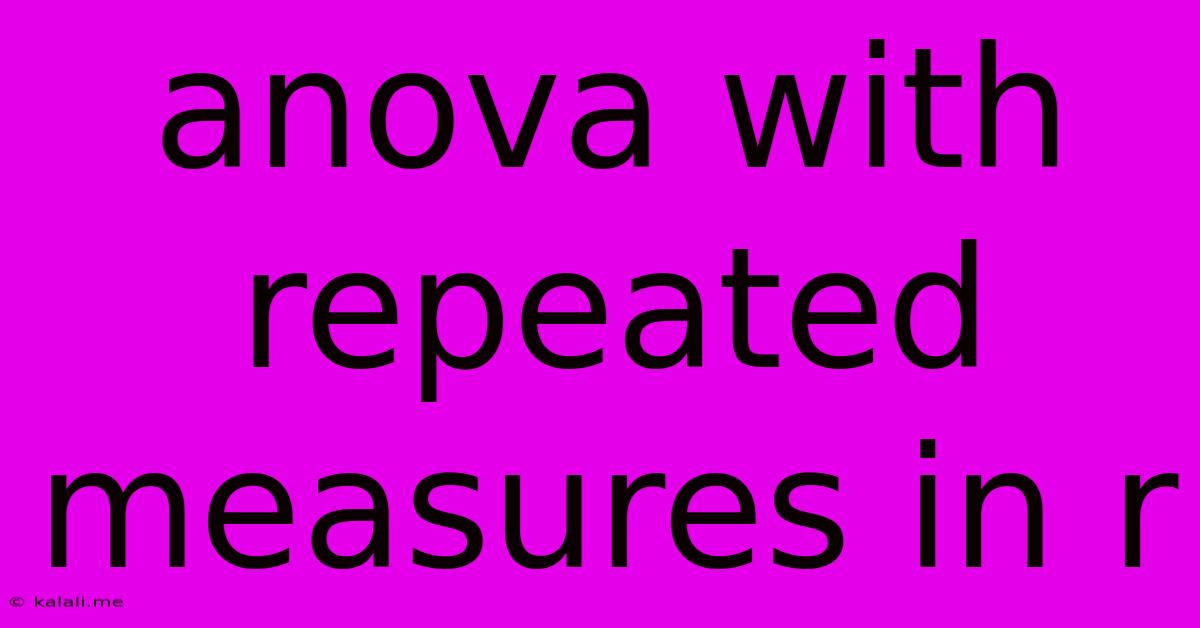Anova With Repeated Measures In R
Kalali
May 27, 2025 · 4 min read

Table of Contents
ANOVA with Repeated Measures in R: A Comprehensive Guide
Analyzing data with repeated measures is crucial in many research fields, allowing us to examine changes within the same subjects over time or under different conditions. This article provides a comprehensive guide on performing repeated measures ANOVA (Analysis of Variance) in R, covering the assumptions, the process, and interpretation of the results. Understanding repeated measures ANOVA will equip you to effectively analyze longitudinal data and experimental designs where the same participants are measured multiple times.
What is Repeated Measures ANOVA?
Repeated measures ANOVA is a statistical test used to compare the means of three or more groups when the same subjects are measured under multiple conditions or at multiple time points. Unlike independent measures ANOVA, which compares means across independent groups, repeated measures ANOVA accounts for the correlation between measurements from the same subject, increasing the statistical power of the analysis. This is because it removes the individual variation between subjects as a source of error. It's particularly useful in experimental designs involving pre- and post-tests, longitudinal studies, or within-subject comparisons.
Assumptions of Repeated Measures ANOVA:
Before conducting a repeated measures ANOVA, it's essential to verify that the data meet the following assumptions:
-
Sphericity: This assumption states that the variances of the differences between all pairs of levels of the within-subject factor are equal. Violation of sphericity can lead to inflated Type I error rates. Tests like Mauchly's Test of Sphericity are used to assess this. If sphericity is violated, adjustments like Greenhouse-Geisser or Huynh-Feldt corrections are applied.
-
Normality: The data within each group should be approximately normally distributed. While ANOVA is fairly robust to violations of normality, especially with larger sample sizes, examining histograms and Q-Q plots is recommended.
-
Independence of Observations: Observations within the same subject are not independent, which is the defining characteristic of repeated measures. However, observations between subjects should be independent.
Performing Repeated Measures ANOVA in R:
Let's illustrate the process with a hypothetical example. Suppose we're investigating the effect of three different training methods (Method A, Method B, Method C) on cognitive performance, measured at three different time points (Pre-training, Post-training, Follow-up). We'll use the aov() function within R's base package, which is a powerful and flexible tool for various ANOVA designs.
First, let's create some sample data:
# Sample data
subject <- rep(1:10, each = 3)
method <- rep(c("A", "B", "C"), 10)
time <- rep(rep(c("Pre", "Post", "Follow"), each = 10), 1)
score <- c(5, 7, 8, 6, 8, 9, 7, 9, 10, 8, 6, 9, 10, 12, 11, 7, 10, 12, 13, 14, 8, 11, 13, 14, 15, 9, 12, 14, 15, 16)
data <- data.frame(subject, method, time, score)
Now, let's perform the repeated measures ANOVA:
# Repeated measures ANOVA
model <- aov(score ~ method * time + Error(subject/(method)), data = data)
summary(model)
This code performs a two-way repeated measures ANOVA with method and time as within-subject factors. The Error(subject/(method)) term specifies the repeated measures structure, indicating that the error term is nested within the subject. The summary() function displays the ANOVA table.
Interpreting the Results:
The output from summary(model) will show the F-statistics, p-values, and degrees of freedom for the main effects of method and time, as well as their interaction. A significant p-value (typically less than 0.05) indicates a statistically significant effect. Post-hoc tests (like Tukey's HSD) can be used to determine which specific groups differ significantly.
If Mauchly's Test of Sphericity indicates a violation of sphericity (p < 0.05), use the summary.aov() function with the mfrow parameter to display adjusted p-values using Greenhouse-Geisser or Huynh-Feldt corrections. For instance, to obtain Greenhouse-Geisser corrections, you might use summary(model, correction = "GG").
Further Considerations:
-
Alternative Approaches: The
ezANOVA()function from theezpackage provides a user-friendly interface for repeated measures ANOVA. Thelme4package offers linear mixed-effects models, a more flexible approach that can handle more complex designs and unbalanced data. -
Effect Size: Calculate effect sizes (e.g., partial eta-squared) to quantify the magnitude of the effects.
-
Visualizations: Create plots (e.g., line graphs, bar charts) to visualize the data and the results of the analysis.
By following this guide and understanding the assumptions, you can confidently perform and interpret repeated measures ANOVA in R, gaining valuable insights from your longitudinal and within-subject data. Remember to always check assumptions and consider alternative approaches when needed.
Latest Posts
Latest Posts
-
Keebler Club And Cheddar Crackers Expiration Date
Jul 10, 2025
-
In Many States Trailers With A Gvwr Of 1500
Jul 10, 2025
-
How Many Tablespoons Are In A Hidden Valley Ranch Packet
Jul 10, 2025
-
Which Is The Best Summary Of The Passage
Jul 10, 2025
-
How Many Quarts Of Soil In A Cubic Foot
Jul 10, 2025
Related Post
Thank you for visiting our website which covers about Anova With Repeated Measures In R . We hope the information provided has been useful to you. Feel free to contact us if you have any questions or need further assistance. See you next time and don't miss to bookmark.